This is a Veteran Owned site
![]()
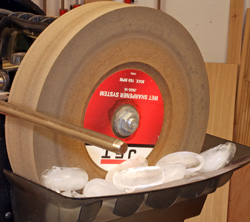 |
Many woodworkers do not have the luxury of a full-time heated shop space so the freezing of a water-bath grinding wheel is a concern. Here we look at a possible solution, literally. Click image to enlarge |
Winterizing Water Bath Grinding Stones
The antifreeze mystery is less mysterious
Text, photos and video by Tom Hintz
Posted – 1-14-2011
Check out our companion story on trying to freeze plain water in a brand new stone! Click Here to see that story!
Disclaimer: It is important to note that this story focuses on a JET stone grinding wheel. I cannot predict how stone grinding wheels from other manufacturers will respond to the conditions in this story. I used Sierra brand antifreeze for this story because it claims to be “safer” and “less toxic” than traditional antifreeze formulas. Though I looked high and low, I could not find a “totally safe” antifreeze so keep that in mind. The Sierra brand is formulated using propylene glycol rather than the ethylene glycol that was so commonly used before and proved to be both attractive and lethal to people and animals. Regardless of safety claims made on a label, I am taking precautions to keep this stuff separate from people and animals just to be safe and I suggest you do also. This test was done in my garage-based shop in Concord, North Carolina so folks in Alaska and such may want to use a stronger antifreeze mixture if your shop gets much colder than mine does!
Update:
Since posting this story I have been re-saturating the same JET stone grinding wheel in the 50% antifreeze mixture to see if it would kill the stone. As of 1-22-2011 nothing about the stone has changed other than it is a shade or two darker. It sharpens fine, is not soft and is not sealed (gummed) up.
The Problem
The super porous nature of stone grinding wheels means that they absorb huge amounts of water. Because so much water is deep within the stone even when the water tank is removed it can take several days for all of the water to drain and evaporate from the interior. The problem is that the stone can freeze all of the way through much faster than it can drain. If moisture within the stone freezes, it expands. When that happens within a stone wheel there is a good chance that it will crack or break entirely. The only option then is a new stone.
Over the years I have been asked repeatedly about using various antifreeze products to protect the stone but have never found a hard and fast answer about how antifreeze might impact the stone itself, its sharpening properties or if it will in fact protect the stone from freeze damage. The advice from manufacturers has always been to remove/empty the water tank and take the whole machine or the stone itself into a heated area. This answer is no big problem for some but a major pain in the behind for others. The cost of energy these days means that keeping a shop warm enough to prevent your stone grinding wheel from freezing could be costly.
The “Test” Shop Environment
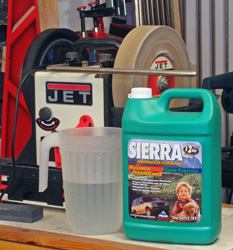 |
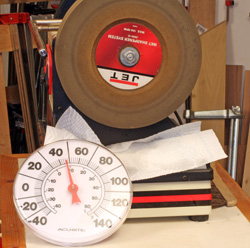 |
I used the Sierra brand antifreeze (left) because it is "safer" for people and animals. However, nothing I could find is totally safe so precautions must always be taken with this stuff! My shop isn't heated but this 40-something temperature (right) is pretty common even though I was sure it was much colder in there. Check yours! Click images to enlarge |
|
This test was done in my garage-based shop in Concord, North Carolina. The area is 20’ by 24’ with a 7’-tall ceiling. The ceiling is dry walled but only partially insulated as there is nothing but an empty attic space above it. The walls are 2 by 4 construction with 3-1/2”-thick fiberglass insulation and no windows in the outside walls. The outside wall insulation is covered by ¼”-thick wood particle paneling. This shop space has two overhead garage doors that also have no windows. The garage doors are insulated steel with wind-stopping strips on the edges.
There is no full-time heating source in the garage. I do have space heaters that I run to bring the in-shop temperature up for working but none of these stay on when I am not in the shop. To stabilize the environment I left all of the heaters off a full day in advance of beginning this test.
Know Your Situation
It is important to know just how cold your shop really gets. I would have sworn that it gets well below freezing in my shop but with a shiny new thermometer standing next to my JET Wet Sharpener and outside temperatures down to 14-degrees (Fahrenheit) the shop temperature barely got below 30-degrees. I have a vent in one of the garage doors and for this review will leave that uncovered with my JET Wet Sharpener (and thermometer) placed directly in front of that opening to be sure that the stone is exposed to freezing temperatures. It will be up to you to determine your shop environment in terms of temperature variations and to use the antifreeze you choose according the directions on the container.
Establishing a Baseline
I began the test by loading my JET stone with plain water, grading the surface for 30 seconds (coarse side of the grader) and sharpening one of my favorite tools spindle gouges. I want to establish a baseline in terms of the stones surface and how it cuts. One of the theories about using antifreeze is that it could lubricate the stones surface and reduce its grinding effectiveness. Following this baseline sharpening with plain water I removed the tank, flushed it out and let the stone air dry for a week before adding the antifreeze mixture.
The Antifreeze Mix
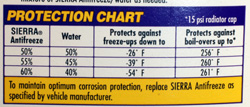 |
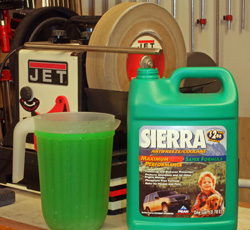 |
The chart on the Sierra bottle (left) shows the protection offered by different concentrations. I chose 50-50 to be sure I had a good concentration of antifreeze so I could see what it might do to the stone wheel. I just mixed the water and antifreeze in a pitch (right) and saturated the wheel just as with water. Click images to enlarge |
|
A chart on the label of the antifreeze bottle shows the level of cold protection different concentrations of the antifreeze in water will provide. I chose the 50/50 mixture as that lists protection down to 26-degrees-below zero which would be desirable in many parts of the world.
I also wanted to use a good amount of antifreeze in the solution to better judge whether it might make the grinding surface slick or ineffective. That is part of why some say not to use antifreeze so I need to look at that as part of this test. A good amount of antifreeze in the wheel also lets me see if the stone itself or the binders that hold it together are degraded by antifreeze.
Lubricity Test
After loading the same wheel with the 50/50 antifreeze solution and letting it run for several minutes to be sure it is fully saturated I again graded the surface (coarse side of the stone again) for 30 seconds to be sure we had the same surface as in the initial testing.
I ground the same spindle gouge using all of the same settings established during the pure water part of this test. The feel, sound and apparent sharpening speed felt no different with the antifreeze/water solution than with pure water. I coated the bevel of the gouge with magic marker to be sure I was still grinding the full bevel and it was.
I let the stone run a while longer just to be sure it was fully loaded with the water/antifreeze mix and repeated the sharpening test. Once again there was no discernable difference in the grinding between this antifreeze mix and the original pure water bath.
Out in the Cold
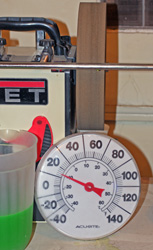 |
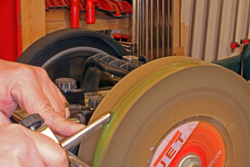 |
The lowest temperature we saw during the test was 14-degrees (left) measured at the stone wheel. Each day I re saturated the wheel with the water/antifreeze solution and sharpened my spindle gouge. (right) The grinding properties of the wheel never changed enough for me to notice. And the wheel stayed hard with no cracks or degradation I could find. Click images to enlarge |
|
I removed the water tank containing the water/antifreeze mixture from the JET Sharpener and set it next to the machine. I let the stone drain normally in the cold with no fans or other air movement helping evaporation along.
I wanted a worst-case scenario so the last thing I did before closing up the shop was to run the wheel in the antifreeze/water solution again to re saturate the stone. Then I again removed the tank and let the stone drain on its own.
I placed the sharpener stand next to the vent in the door with the stone as close to the vent as possible. Then I closed down the shop and left the stone to fend for itself overnight. I would learn the next morning that temperatures were in the mid to low 20’s throughout the night and the thermometer set next to the stone showed 24-degrees when I first went into the shop the next morning. Subsequent days would show morning temperatures at the stone wheel as low as 18-degrees.
Each morning during the test the stone looked fine with no cracks or anything else odd-looking about it. It still felt damp to the touch and the surface appeared to be as hard as it ever was. Over the course of this weeklong test the antifreeze/water saturated stone wheel has been exposed to freezing temperatures (nighttime at least) each of the seven nights. In that time I have repeatedly brought the wheel to full saturation with the antifreeze/water mixture, graded its surface and sharpened my chisel with no apparent loss of grinding effectiveness. Also, the stone remains as hard as ever with no signs of degradation detectable.
I repeated the sequence of saturating, grading and then sharpening of the same chisel each day. After sharpening the tank was removed and the wheel allowed to drip/evaporate at its own rate. The JET sharpener was returned to its spot by the garage door each day where the stone wheel was aligned with the vent to maximize the cold to which it would be exposed. During this process there had been no heating in the shop. The highest temperature seen in the shop (from the photo lights mainly) was 38-degrees.
Conclusions
Video Tutor |
After a full week of exposure to the 50/50 mixture of Sierra antifreeze and water the JET stone grinding wheel shows no signs of degradation structurally or in its ability to sharpen. If there is a lubricating effect on the wheel it is too minor to detect. Throughout the test it never seemed to take longer to sharpen a tool and the finish on the ground edge is as good as it ever was if not a tick cleaner.
I noticed that after letting the saturated wheel sit for several minutes, the top surface did not feel greasy or overly slick. That suggests that the antifreeze/water solution does in fact sink into the pore structure of the stone rather than accumulating at the surface as some speculated that it would. The stone seems to be just as hard as it was before the test began, it takes grading as it did before and it sharpens tools just as quickly as it does with plain water. In short, nothing has changed with the addition of the antifreeze/water solution.
I must stress that you have to judge your own situation. I have not tested stone wheels other than the JET wheel that came on my JET grinder. I have not done this test in your shop or your state so you have to go into this with your eyes open and pay attention to your climate. In my shop, in my climate, adding the Sierra antifreeze prevented my JET stone grinding wheel from breaking while not reducing its sharpening performance.
Despite the Sierra brand being “safer” we have to take the label warnings seriously and prevent this material from being available to children, animals or unsuspecting people. In sufficient quantities it is still dangerous and we have to assume the worst. As always, be safe if you choose to use this or similar materials in your shop!
Visit the Sierra Antifreeze web site – Click Here
Visit the JET Tools web site – Click Here
Have a comment on this story? –Email Me!
All written, photographic and drawn materials are property of and copyright by NewWoodworker.com LLC 2000-2019. Materials may not be used in any way without the written permission of the owner.
